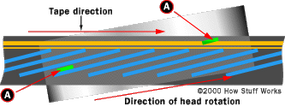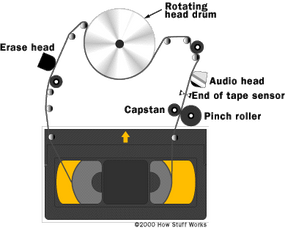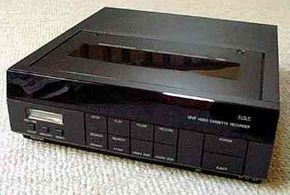The VCR
In 1956, the first commercial reel-to-reel videotape recorder was created by Charles Ginsburg and Ray Dolby while working for the Ampex Corporation. This new device was a major development for television broadcasters because it marked the first time that shows could be recorded and broadcast later. Prior to 1956, all shows on television were live.
Sony created the first inexpensive VCR in 1969. In 1976, the VHS tape format appeared and began its domination of the market. Video stores were soon to follow. Blockbuster opened its first video store in Dallas, Texas, in October of 1985, and went on to open 9,000 stores across the U.S. (In 2023, just one Blockbuster store remained.)
Advertisement
The VCR itself has two jobs:
- It must deal with the tape — an extremely thin, fairly fragile and incredibly long piece of plastic.
- It must read the signals off the tape and convert them to signals that a TV can understand.
Both of these are formidable tasks, and the second one was a big technological challenge. In sound recording, the sound information is stored linearly on the tape. That is, the tape moves past the recording head and the sound information is laid down as a long line following the length of the tape. The tape might move past the head at a speed of 2 or 3 inches (5 - 8 cm) per second. A video signal contains perhaps 500 times more information than a sound signal, so the same approach cannot work. The tape would have to be moving past the head at a rate of many feet per second.
To solve this problem, two recording heads are mounted on a rotating drum that is tilted with respect to the tape. A television image is divided into a series of 525 horizontal scan lines, half of which are displayed every 60th of a second. Each pass of the VCR's rotating head reads or writes the data for one field (262.5 scan lines) of the television image. Therefore, the data recorded on the tape looks like this:

In this figure, the light blue bands are individual fields laid down by the recording head of the rotating head drum. Since the drum contains two heads on opposite sides of the drum (180 degrees apart), the two heads alternate, each one reading or writing every other band. The yellow tracks represent the audio and control tracks. The control track is especially important:
- It tells the VCR whether the tape was recorded in SP (standard play), LP (long play) or EP (extended play) mode.
- It tells the VCR how quickly to pull the tape past the drum (since the tape may stretch or shrink over time).
- It gets the heads lined up with the bands during playback. When you play with the "tracking" control on your VCR, what you are doing is adjusting the skew between the control track and the actual head position on the tape. Usually, this is not necessary, but if a tape is badly worn or stretched you may have to adjust the tracking.
The relationship between the tape and the rotating head drum is shown in this figure:


The head is rotating at 1,800 revolutions per minute (rpm), or 30 revolutions per second. In SP mode, the tape moves past the head at 1.31 linear inches per second (33.35 mmps). In LP mode, it's 0.66 ips (16.7 mmps), and in EP mode it's 0.44 ips (11.12 mmps). Because of the head rotation, however, the head is moving over the tape at 228.5 inches (5804 mm) per second, or about 25 mph (41 kph). That means that if the video information were being stored linearly, you would need a 50-mile-long (80-km-long) tape to store a two-hour movie. Obviously, the rotating head approach, also known as helical scanning, saves a lot of tape.

The only problem this creates is that a VCR designer has to get the video tape to wrap around the rotating head in order to record or play back the tape. In addition, the device has to read the audio and control tracks from the tape, keep the tape moving at exactly the right speed and detect the end of the tape. To do all of this, the tape has to follow a tortuous path, like this:
Different VCRs use different approaches, but you get the idea. The drive mechanism in the VCR has to extract a good long piece of tape from the cassette and wrap it around a variety of rollers, drums and heads in order to play the tape. It is absolutely amazing that a VCR ever works.
